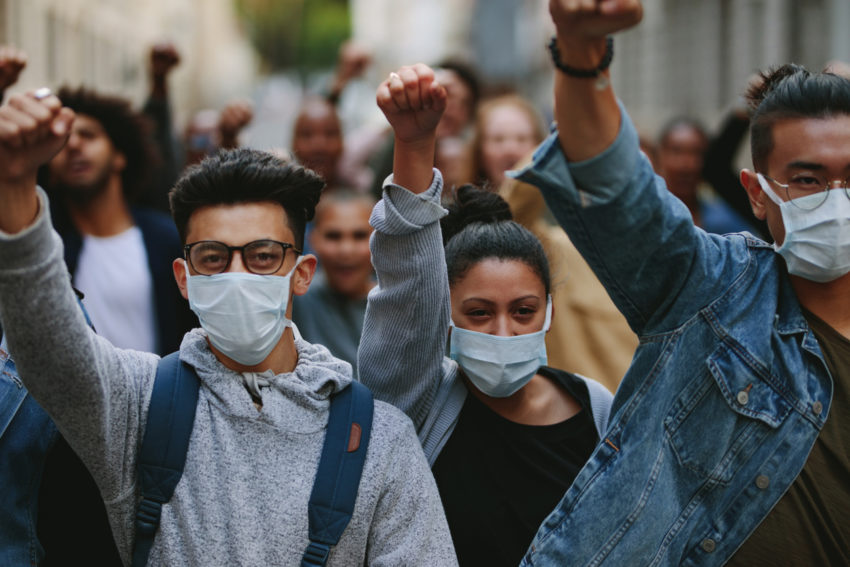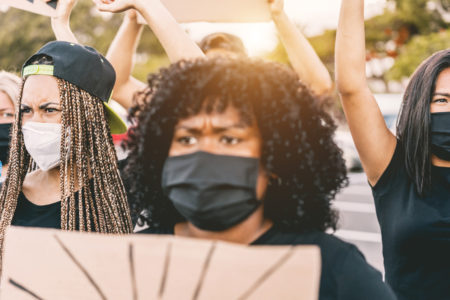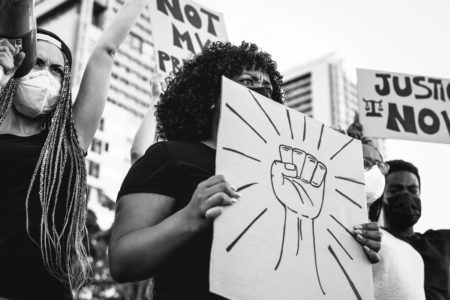
Share On Social!
With student pressure, universities across the nation are beginning to make statements and take action to address the systemic racism that impacts students, staff, and faculty of color.
These statements from universities come as a result of the Black Lives Matter movement. As the discussion about injustices that Black people, Latinos, and other people of color face from law enforcement and other authorities continues to grow, it gave room for students to confront university administrators about racial injustices happening on campuses.
Many universities are committing to change and putting new policies in place. Others are making statements in solidarity, but with less of a commitment to change.
How can students be sure their universities are serious about these statements?
Racism in Higher Education
Racism in higher education is not a new concept.
Often, the structure and history of a university is embedded in racist or biased thought or action.
“Colleges and universities built curricula and performed research that supported the enslavement of Africans. Money from the African slave trade and slavery financed institutions of higher education,” according to The New Republic.
Ideas about racial inferiority were preached in the classroom. Statues of prominent slaveowners stood over campuses.
Even after the Civil Rights Movement, inequities persisted.
Today, Latinos do not get a fair share of seats or degrees from colleges in nearly every state when compared with their white peers. And it’s not about a lack of talent or aspirations among Latinos—it’s the result of “structural racism and injustices throughout the education pipeline” that make it harder to pursue high education, according to research from The Education Trust.
For example, Historically Black Colleges and Universities (HBCUs) and Hispanic-Serving Institutions (HSIs) are consistently underfunded.
Black and Latino students continue to be at a disadvantage in higher education.
“Black and Latinx students are more likely to receive educations from institutions that are less funded, have higher dropout rates, operate for profit, pay lower faculty salaries and have higher student-to-faculty ratios. The educational spending gap alone gives white students a $5 billion advantage over students of color at public colleges every year, and spending directly impacts student graduation rates,” said Krishi Metivier, according to Inside Higher Ed.
There are problems with diverse representation in university faculty as well.
Latinos only make up 3% of full-time professors at colleges and universities, according to the National Center for Education Statistics.
Having a diverse faculty can make a substantial difference in the campus climate.
“Scholarship has consistently shown that racial and ethnic diversity has both direct and indirect positive effects on the educational outcomes and experiences of students. The campus is a more welcoming place when the diversity of the student population is also represented among the faculty—underrepresented students feel less that they are “strangers in a strange land,’” according to the American Federation of Teachers.
This historical context has led to the educational injustices facing people of color today. Just as students helped make the change during the Civil Rights Era, students are now organizing to hold their universities accountable.
Universities Making Calls to Action
Across the country, students are pushing universities to address their racist pasts and present.
After the killing of George Floyd by law enforcement, the president of Princeton University outlined steps they would take to address systemic racism on campus.
“Racial justice demands the scholarly and practical attention of this University. Princeton contributes to the world through teaching and research of unsurpassed quality, and we must continue to find ways to bring that mission to bear against racism, and against all of the discrimination that damages the lives of people of color,” president Christopher Eisgruber wrote in a letter to the community.
Eisgruber’s letter detailed some of the changes he intends to enact. These included new funding initiatives on racial injustice, new grant programs for students to work on addressing racial inequalities and injustices, expanding diversity among faculty, and changing the names of buildings that previously honored people with racist policies.
Ohio State University also started a new grant fund to help students research racial disparities.
“Together, we grieve for George Floyd, Ahmaud Arbery, Breonna Taylor and so many other black and brown people who have lost their lives as a result of institutional racism,” said Ohio State president Michael Drake in a statement, according to Diverse Issues in Higher Education. “We are outraged, and we are all reflecting on what this moment means. We must be the change we want to see.”
Drake has also stated he supports the resolution to declare racism a public health crisis in Ohio.
The University of Illinois also made a statement on the policy changes they intend to enact.
“Led by the Office of the Vice Chancellor for Diversity, Equity and Inclusion, this Call to Action initiative will lay out a framework for how we make this transformation and establish a series of working groups charged with taking concrete steps forward to dismantle systemic racism and injustice that are both measurable and accountable by the end of the coming academic year,” said the statement.
Some universities, including University of Texas at Austin, have credited the students and faculty for raising awareness of the need to address systemic racism.
“After hearing concerns from Black students and others and leading many heartfelt discussions with students, alumni, staff and faculty, I announced a series of measures that we have already begun to implement. Although change takes time, we are making meaningful progress,” said Jay Hartzell, president of University of Texas at Austin, in an email to the UT community.
Some of the initial systemic changes coming to University of Texas at Austin are focused on recruitment, according to Hartzell.
“Just last week, we approved the first $1 million in new funds to expand student recruitment, outreach and community engagement in Dallas, Houston and the Rio Grande Valley to reach and support talented students from underrepresented communities and launched a new diversity, equity and inclusion website and a page where the community can track our progress,” Hartzell wrote.
Students also played a large role in addressing systemic racism at Oregon State University, where student leaders hosted a webinar on racial inequity.
“The students were very clear that they wanted to keep this momentum going in the sense that folks are paying attention and thinking strategically about these conversations,” said Charlene Alexander, vice president and chief diversity officer at Oregon State, according to Diverse Issues in Higher Education.
At Florida State University, student leaders took part in a meeting with the university president and several Tallahassee city officials, including the mayor and police chief, as part of the first steps in addressing racism.
“I want to assure our students and everyone in our campus community that my commitment goes beyond hosting meetings and issuing statements,” said president John Thrasher in a statement, according to Diverse Issues in Higher Education. “I am listening, and my administration is committed to making long-term, sustainable changes to ensure that FSU and the Tallahassee community is a place where every single person is treated with respect and dignity and feels safe.”
Now it’s up to the students to decide if the actions their universities are taking are enough.
Can Students Trust their Universities to Commit to Change?
Issuing a statement to stand in solidarity with students and faculty of color is important.
But some students feel that action needs to go beyond that.
“The chancellor of the University of Wisconsin-Madison, Rebecca Blank, released a statement that read, in part, ‘To our Black and Brown students, staff and faculty, I want to say unambiguously: You belong here, you are important to this campus, your lives matter and I am committed to your safety,’” according to the Hechinger Report.
Student leaders wanted to see more specific plans to enact change.
“I feel like it’s completely lip service, with no actions and no specific next steps,” said Nalah McWhorter, president of the Black Student Union, according to the Hechinger Report.
Other instances of students wanting more from administrators involve leaving out mentions of racism or police brutality from university statements.
“Many Black students at North Carolina State University were angered by a statement put out by Chancellor Randy Woodson, which made no mention of police brutality,” according to the Hechinger Report.
Even when student activists were organizing close to campus, administrators at the University of Georgia did not address racism head-on.
“On May 31, during a peaceful demonstration against police brutality in downtown Athens, Georgia, protesters were teargassed when they walked to the University of Georgia Arch. President Jere Morehead released a statement that mentioned neither racism nor police brutality. After swift criticism, he released a more pointed statement, via email, but some students felt it was too little too late,” according to the Hechinger Report.
Other issues stem from the commitment to increase diversity.
Students at the University of Michigan have historically fought for enrolling more Black and Latino students, but the numbers continue to stay low.
“Black enrollment currently stands at just under 5 percent in a state where black 18- to 24-year-olds make up 17 percent of the population,” according to the Washington Post.
What Can Students Do?
Black and Latino students deserve to have a college experience unmarked by systemic racism.
All members of a university’s community must come together to hold their school accountable to make the changes they need so that all students can get the education they deserve.
Metivier of Inside Higher Ed recommends the following policy changes for universities:
- Ensure responsibility and accountability by publicly denouncing all forms of racism, discrimination, and bias.
- Implement a hate and bias incident reporting system that properly addresses racist issues.
- Counter a legacy of racism by increasing funding for departments that focus on social justice and race studies.
- Create partnerships with other predominately Black and Latino institutions and pathways for low-income, disadvantaged communities to attend your university.
- Publicly report goals and progress to address racism.
Universities may also be able to follow the lead of numerous cities that have passed a resolution declaring racism a public health crisis with a commitment to policy and system change.
The bottom line is that universities must do something, Metivier wrote.
“Being passive will only ensure that we will still have racial inequities far into the future,” Metivier wrote.
Explore More:
Overcoming Harmful BiasesBy The Numbers
3
Big Excuses
people use to justify discriminatory behavior





